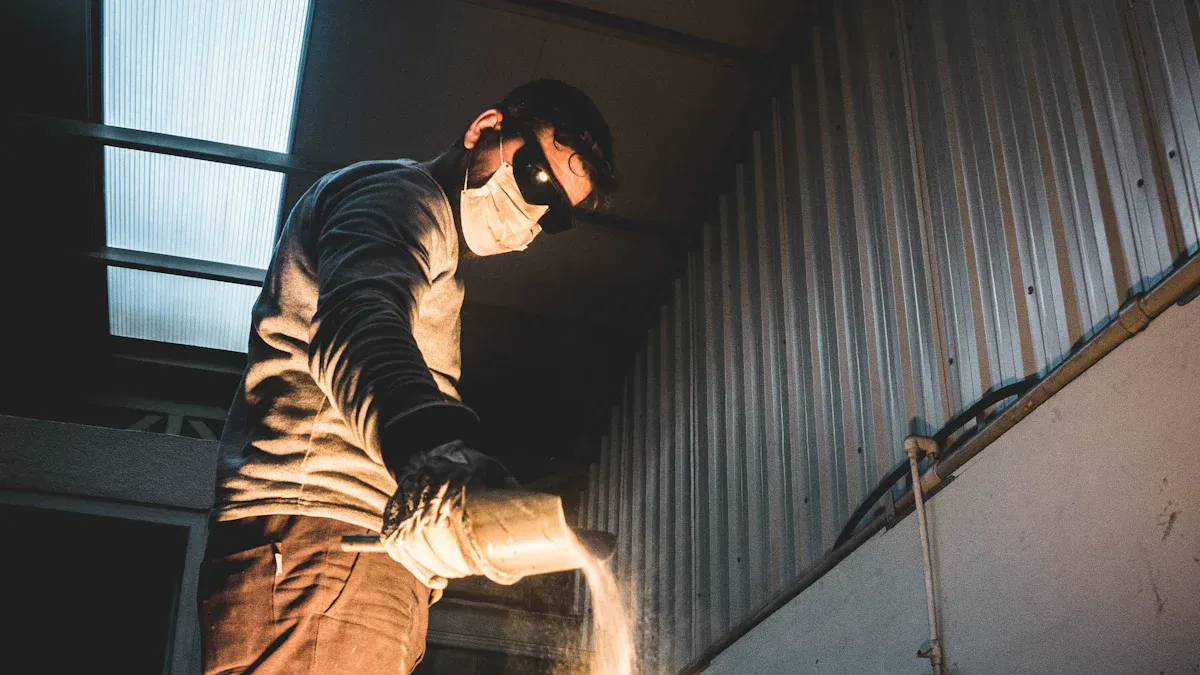Understanding the Fire Resistance of Durable Aluminum Materials

Aluminum exhibits remarkable fire resistance capabilities. It does not ignite or burn, making it ideal for high-temperature environments. With a melting point of around 660 degrees Celsius, aluminum can withstand significant heat without deteriorating. In comparison, many other materials fail to offer such resilience.
The importance of fire resistance in construction cannot be overstated. It ensures the safety of structures and occupants, particularly in high-rise buildings. Choosing durable fireproof aluminum can significantly enhance fire safety measures in modern architecture.
Key Takeaways
Aluminum does not catch fire. This makes it safe for buildings in areas that are likely to have fires.
Aluminum melts at 660 degrees Celsius. It stays strong up to 150 degrees Celsius, which helps keep buildings safe during fires.
New aluminum coverings have non-flammable centers. This improves fire safety and follows building rules.
Aluminum is light and does not rust. This makes it last longer and lowers maintenance costs for owners.
Using aluminum helps the environment because it can be recycled completely. It also helps make buildings use less energy.
The Science of Aluminum's Fire Resistance

Thermal Conductivity
Aluminum exhibits excellent thermal conductivity, which plays a crucial role in its fire resistance. This material conducts heat rapidly, allowing for quick heat dissipation. As a result, aluminum helps prevent localized hot spots during a fire. Its ability to efficiently dissipate heat contributes to maintaining structural integrity under extreme conditions. This characteristic is particularly beneficial in high-rise buildings, where rapid heat transfer can mitigate the risk of catastrophic failure.
Melting Point and Behavior in Fire
Aluminum has a high melting point of approximately 660 degrees Celsius (1220 degrees Fahrenheit). This temperature is relatively low compared to other metals, but aluminum maintains its strength up to about 150 degrees Celsius (300 degrees Fahrenheit). During a fire, aluminum can endure significant heat for a considerable time before melting. This behavior is vital, as aluminum alloys can maintain their structural integrity for several minutes during severe fires before they begin to fail. Such resilience ensures that structures remain stable long enough for occupants to evacuate safely.
Alloy Composition and Its Impact
The fire resistance of aluminum cladding systems is influenced by the core materials used in aluminum composite panels (ACPs). Historically, these cores included flammable substances like polyethylene, which posed fire risks. However, modern advancements have led to the use of non-combustible or thermally stable core materials. These innovations significantly enhance fire safety and ensure compliance with stringent standards. As a result, architects and builders can confidently use aluminum in various applications, knowing it meets necessary fire safety requirements.
Classifications of Fire Protection Levels
Understanding the classifications of fire protection levels is essential for evaluating materials used in construction. Fire resistance ratings help determine how well a material can withstand fire exposure. The following table outlines various fire classes and their characteristics:
Fire Class | Description | Flame Spread Rating |
|---|---|---|
Class A | Involves solid materials like wood, trash, and textiles. | 0 - 25 |
Class B | Involves flammable liquids like gasoline and oil. | 26 - 75 |
Class C | Involves electrical components and equipment. | 76 - 200 |
Class D | Involves metals that can ignite. | 201 - 500 |
Class E | Materials with a flame spread rating above 500. | > 500 |
Durable fireproof aluminum typically achieves high fire resistance ratings. The following table illustrates the fire resistance ratings specifically for this material:
Classification | Description |
|---|---|
Class 0 | Best fire performance, non-combustible, does not contribute to fire spread. |
Class 1 | Non-combustible, slight variations in fire performance. |
A1 | Anodised aluminium, non-combustible. |
A2-s1,d0 | Polyester powder-coated aluminium, if fire-tested correctly. |
To ensure compliance with fire safety standards, various testing methods evaluate the fire resistance of aluminum materials. Key standards include:
ASTM E 136: Evaluates materials' behavior in a high-temperature furnace, classifying materials like aluminum as non-combustible.
ASTM E 119: Tests the fire resistance of building materials by exposing them to a standard time-temperature fire curve.
NFPA 285: Assesses flame propagation characteristics of non-load-bearing wall assemblies containing combustible components.
Compliance with building codes is crucial for fire-resistant aluminum cladding. The following table summarizes key requirements:
Requirement | Description |
|---|---|
IBC | Requires exterior cladding materials for buildings over 40 feet in height to be tested per NFPA 285. |
ASTM E119 | Major fire-resistance testing requirement for exterior wall assemblies. |
NFPA 285 | Testing standard for assemblies with combustible water-resistive barriers. |
MCM Systems | Must achieve the required fire resistance rating of the wall assembly. |
These classifications and standards ensure that durable fireproof aluminum meets necessary fire safety requirements, contributing to overall fire protection effect in construction.
Advantages of Using Aluminum Materials
Lightweight and Structural Integrity
Aluminum's lightweight nature significantly contributes to its structural integrity. This material boasts an impressive strength-to-weight ratio, allowing it to provide substantial strength while remaining easy to handle. Such characteristics make aluminum ideal for high-rise construction, where reducing weight can enhance overall stability. Builders appreciate how aluminum maintains its durability over time, ensuring that structures remain safe and reliable.
Corrosion Resistance
Aluminum exhibits excellent corrosion resistance, enabling it to withstand harsh environmental conditions. This property ensures that structures maintain their integrity and aesthetic appeal over time. The durability of aluminum against water, UV rays, and other corrosive elements enhances its suitability for architectural applications. As a result, aluminum structures require less maintenance, which can lead to significant cost savings for building owners.
Aluminum's heat-reflective properties also help reduce energy costs. By reflecting sunlight, aluminum minimizes heat absorption, contributing to improved energy efficiency in buildings. This feature aligns with modern sustainability goals, making aluminum a preferred choice for environmentally conscious construction.
Sustainability and Recyclability
Aluminum stands out for its sustainability and recyclability. This material is 100% recyclable and can undergo mechanical processing without losing its essential properties. Such infinite recyclability positions aluminum as a crucial component in sustainable construction solutions. Its lightweight and corrosion-resistant nature further enhances its appeal, as it contributes to energy savings and reductions in greenhouse gas emissions.
Aluminum's role in promoting sustainability extends beyond its recyclability. The use of aluminum in construction supports the development of energy-efficient buildings, which is vital for reducing overall environmental impact. By choosing aluminum, builders can incorporate safety features that enhance fireproof capabilities, ensuring that structures remain safe for occupants.
Practical Applications in Construction

Fire-resistant aluminum plays a crucial role in modern construction, particularly in high-rise buildings. Its non-combustible nature allows it to withstand high temperatures without burning. This characteristic makes aluminum cladding an ideal choice for enhancing safety standards in tall structures. Modern aluminum cladding systems often utilize non-combustible cores, such as those found in innovations like Alfrex FR. These systems comply with safety standards like ASTM E84 and NFPA 285, ensuring that they effectively prevent fire spread.
In addition to high-rise buildings, aluminum cladding systems are widely used in facades and roofing. These systems not only provide aesthetic appeal but also enhance fire protection capabilities. Aluminum cladding effectively prevents fire from spreading along building exteriors, which is vital for maintaining structural integrity during a fire. Custom aluminum facade systems can be designed to meet the latest fire safety regulations, ensuring buildings are equipped to handle fire emergencies. This adaptability allows architects to create visually appealing designs while prioritizing safety.
Aluminum also plays a significant role in fire safety systems within buildings. Its non-combustible properties significantly reduce the risk of fire spreading. Aluminum is commonly used in fire partitions, fire doors, and smoke venting windows. These components are essential for controlling fire spread and ensuring occupant safety. Fire partitions compartmentalize areas to prevent rapid fire spread, while fire doors resist high heat and block flames and smoke. Smoke venting windows framed with aluminum allow smoke and heat to escape, improving visibility and facilitating safer evacuations.
Overall, the integration of fire-resistant aluminum in construction not only enhances safety but also meets stringent building codes and regulations.
Aluminum's fire resistance capabilities make it an exceptional choice for construction. Key features include its non-combustibility, regulatory classification as non-combustible, and applications in fire safety systems. The following table summarizes these attributes:
Key Feature | Description |
|---|---|
Non-combustibility | Aluminum does not ignite or burn under normal conditions, reducing fire spread risk. |
Regulatory Classification | Classified as non-combustible by ASTM E 136 and British Standard BS476. |
Applications in Construction | Used in fire partitions, fire doors, and smoke venting windows for fire safety. |
Modern Cladding Innovations | Features non-combustible cores to enhance fire resistance, such as Alfrex FR composite materials. |
Heat Conductivity | Rapidly spreads heat away from the source, maintaining structural integrity during a fire. |
Spark and Smoke Production | Does not produce sparks or smoke, preventing ignition of other materials and maintaining visibility. |
Choosing aluminum for fire safety is crucial. Its ability to withstand considerable heat without igniting significantly reduces fire spread risk. This characteristic enhances overall safety in construction projects. Builders should prioritize aluminum to comply with safety regulations and building codes. By considering durable fireproof aluminum, they can ensure safer environments for occupants in future projects.
FAQ
What are non-combustible materials?
Non-combustible materials do not ignite or burn when exposed to fire. Aluminum is a prime example of a non-combustible material, making it suitable for construction in fire-prone areas.
How does aluminum perform in high temperatures?
Aluminum exhibits excellent fire performance due to its high melting point. It can withstand significant heat without burning, ensuring structural integrity during fires.
Are there fire-resistant options for aluminum cladding?
Yes, there are various fire-resistant options available for aluminum cladding. Many modern systems utilize non-combustible cores to enhance fire safety and comply with building codes.
Why is aluminum considered a high-temperature resistant material?
Aluminum's ability to maintain strength up to 150 degrees Celsius (300 degrees Fahrenheit) makes it a high-temperature resistant material. This characteristic is crucial for ensuring safety in construction.
How do I ensure compliance with fire safety standards?
To ensure compliance, builders should select aluminum products that meet established fire safety standards, such as ASTM E 136 and NFPA 285. These standards verify the non-combustible nature of materials.